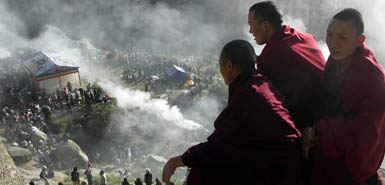Tibetan Buddhist monks on a hillside above the Drepung Monastery where the protests began

Paramilitary police have surrounded Tibet’s most important monasteries after hundreds of monks shouting “Long live the Dalai Lama” defied Beijing in the biggest protest in the Himalayan region for almost 20 years.
Witnesses described violent clashes between monks and police on the outskirts of Lhasa on Monday afternoon and reported hearing as many as 60 gunshots as troops forced the monks to return to their quarters early yesterday. They said that about 60 monks from Drepung monastery were detained on the edge of the Tibetan capital and about 11 from Sera monastery were arrested after shouting anti-Chinese slogans.
The demonstrations were timed to coincide with the 49th anniversary on Monday of an anti-Chinese uprising in which the Dalai Lama fled into exile in India and tens of thousands of Tibetans were killed. Around the world, Tibetans took to the streets to commemorate the anniversary and to press demands for independence for the deeply Buddhist Himalayan region before the Beijing Olympics.
Monks took part in three demonstrations across Lhasa on Monday – a show of unrest likely to unsettle the Communist leadership in a year when China is under worldwide scrutiny before the Games in August.
The protests began when 400 monks left Drepung on Monday afternoon and marched about eight kilometres (five miles) as far as the Lhasa Customs office, where a dozen police cars blocked the road. They refused to return to their monastery unless the authorities met a series of demands.
Topping the list was a plea to the Government to grant full religious freedoms to Tibet before the start of the Beijing Games, a source at one monastery said. They also demanded the release of monks detained in purges at Drepung in recent months, including several expelled after they failed to pass tests to demonstrate their allegiance to Beijing and to vilify the Dalai Lama.
The police tried to force the monks to return to Drepung, once the largest monastery in the world with 10,000 monks and now home to about 900. When they refused, clashes erupted. Two columns of covered military trucks, each containing about seven vehicles, arrived to back up the police. Later an ambulance appeared. The monks then staged a sit-in. The police appeared reluctant to take on such a large number of protesters.
Meanwhile, a second group from Drepung monastery, numbering about 100 monks, raced down the hill and headed towards the city. They were stopped by police before they reached the bottom of the hill. They also staged a sit-in and refused to return to their rooms. At about the same time in the heart of Lhasa, around the Jokhang temple that is the holiest site in Tibetan Buddhism, about a dozen monks from Sera monastery – the second-biggest in the city – staged a third demonstration. They waved the banned Tibetan flag, which shows a snow lion. Their shouts of “Long live the Dalai Lama” and “Independence for Tibet” swiftly drew large crowds to the square in front of the temple where hundreds of Tibetan pilgrims arrive each day.
Police appeared from several stations that surround the temple. A Tibetan source said that about 11 monks were detained, with one or two ordinary Tibetans who joined in the shouts. It was not until early yesterday that police and troops were able to end the sit-in by the monks from Drepung. Witnesses said that most of them returned to the monastery but between 50 and 60 were believed to have been arrested.
The numbers could not be confirmed, and Chinese officials said that there had been no arrests. A Foreign Ministry spokesman, Qin Gang, said: “Some ignorant monks in Lhasa abetted by a handful of people did some illegal things that can challenge the social stability.” He said they had been dealt with according to the law.
Reports by monks at Drepung described sounds of gunfire around the monastery at about 2.30am, but it was not clear if anyone was hurt. The monastery was encircled yesterday by hundreds of paramilitary police. In Sera monastery plainclothes police patrolled the halls. Monks there said they were fearful of reprisals and that government teams would launch new re-education programmes.
Champa Phuntsok, the ethnic Tibetan governor of the region, said that the monks had been counselled and released. “It’s really nothing. Everything is great,” he said.
Q&A The Himalayan conflict
Has Tibet ever been independent?
The Beijing line is that Tibet became part of China in the 13th century, when the Mongol Yuan Dynasty extended its rule over the Himalayan region. Most historians say that Tibet was at least a protectorate of China in the 18th and 19th centuries until it unilaterally declared independence in 1913. Chairman Mao’s troops entered central Tibet in 1950
Why did Tibetans rise against Beijing in 1959?
When China imposed land reforms in eastern Tibet and began to destroy monasteries, thousands of refugees fled to Lhasa, setting off a popular uprising. The Dalai Lama, accompanied by thousands of followers, fled into exile in India. Official figures say that 80,000 Tibetans were killed as Chinese troops crushed the rebellion
Have Tibetans always opposed communist rule?
At first Tibetan aristocrats and young intellectuals regarded Chinese rule as a new beginning, but many changed their minds when Beijing imposed land reforms. However, some poor Tibetans welcomed the reforms
Are Tibetans free to worship?
The authorities do not generally interfere in worship by ordinary Tibetans and allow them to visit temples. However, there are some restrictions in monasteries, where lamas must take part in government-run patriotic re-education classes and are required to renounce the Dalai Lama
Does the Dalai Lama want independence?
No. He has given up that idea and says that he is asking for genuine autonomy and this now seems to mean that he wants cultural autonomy, leaving the central Government in Beijing in charge
Jane Macartney in Beijing
March 12, 2008
From: Times